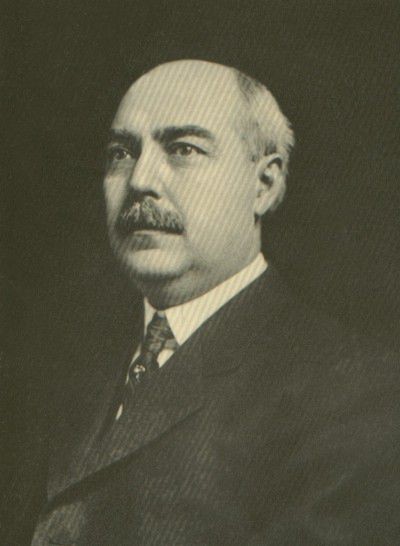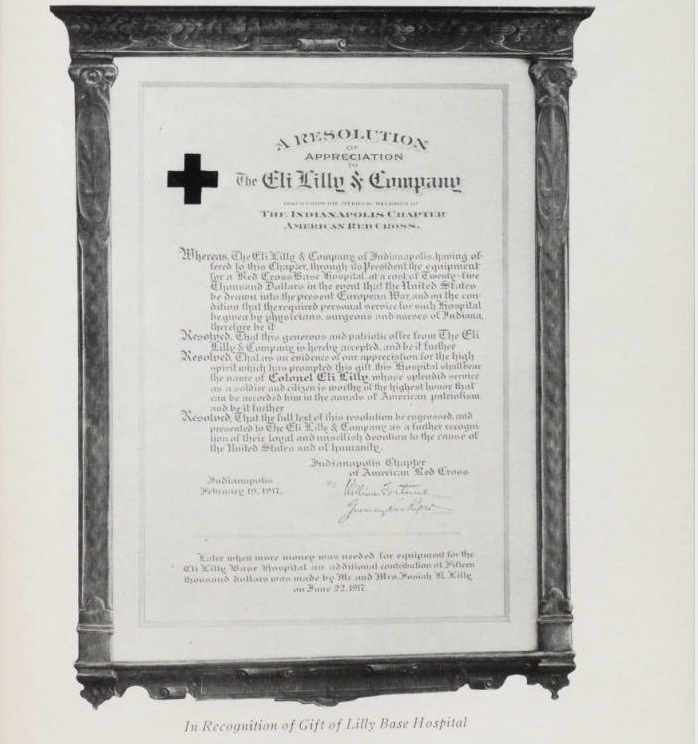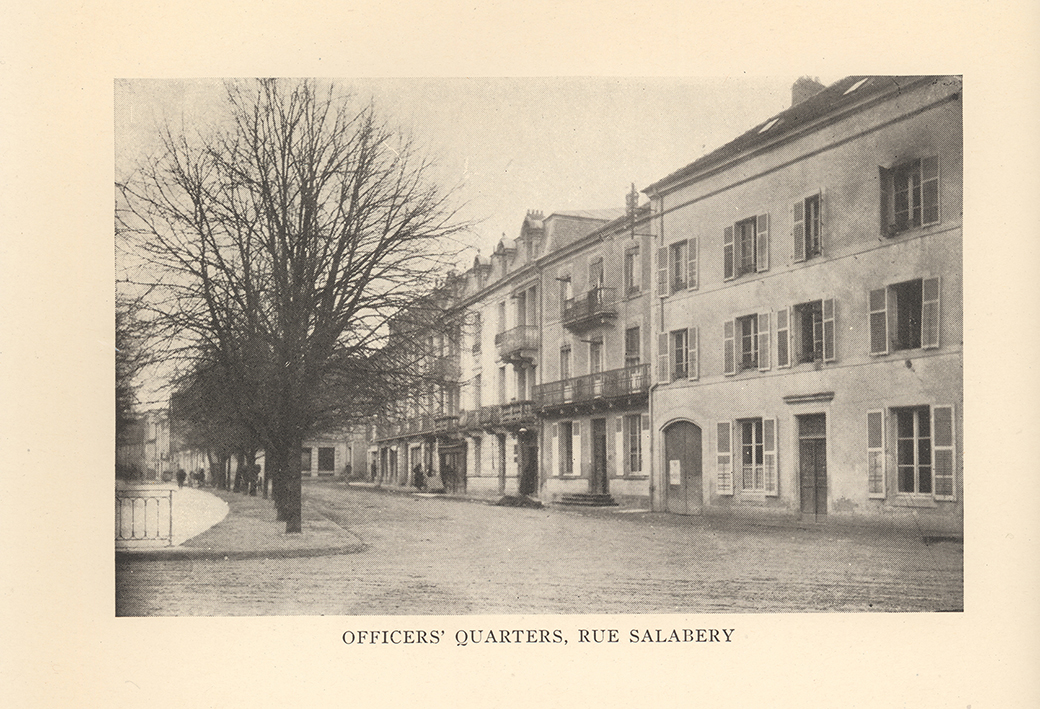J K Lilly
President of Eli Lilly and Company
Base Hospital 32
J. K. Lilly, the president of Eli Lilly & Co., a pharmaceutical company based in Indianapolis, Indiana approached Mr. William Fortune the president of the Indianapolis Chapter of the Red Cross with the idea of organizing a volunteer staff of physicians, surgeons and nurses to serve under the Red Cross in the event of the United States becoming involved in the World War. He offered $25,000 to the Red Cross for necessary equipment and supplies. This generous offer was made in February of 1917 and was contingent upon a declaration of war. By April, the funds were provided and the hospital organization was underway for a 500-bed hospital.
Contrexeville, France
Additional funding was provided through contributions to the local Red Cross, including $15,000 from Mr. & Mrs. Josiah K. Lilly, all totaling $50,000 to cover the cost of acquiring and moving the necessary equipment. Staffing was primarily garnered from Indiana medical personnel, most coming from Indianapolis including Drs. Edmund D. Clark, Orange G. Pfaff, and Carleton B. McMulloch. By August of 1917, the huge effort was organized with a staff of 180, and the work of packing for overseas shipment began. They began with an encampment at Ft. Harrison, Indianapolis under the command of Major Edmund D. Clark, and were officially inducted into the US Army on September 1, 1917, with control passing to the War Department from the Red Cross. The nurses trained at Columbia War Hospital in New York City and St. Mary's Hospital in Hoboken, New Jersey. On December 4th, 1917 they set sail for France on the USS George Washington. See: http://www.wwvets.com/WW1_Navy.asp
Contrexeville, France is located in the foothills of the Vosges mountains, 220 miles East of Paris, and had served as a summer resort featuring mineral waters during more peaceful times. The local casino and four other large hotels provided an ideal facility to be adapted for a military hospital. It was approximately fifty miles behind the front lines with an important rail line running through the town. The location necessitated the hospital size to be increased to 1,250 beds. The newly constructed Royal Hotel was converted to an isolation ward for contagious diseases providing room for 200 patients. The resort hotel was utilized as the rooms could easily be converted for hospital usage.
All of the buildings had to be cleaned and sterilized, lighting adapted, with much plumbing and carpentry required. The original equipment for 500 beds, all shipped from Indiana, provided one of the best-equipped hospital units in the A. E. F. They also had the unfortunate distinction of the first casualty of an American Nurse on foreign soil. May Berry died of pneumonia contracted on the voyage to France. The second contingent of personnel from southwestern Iowa joined the personnel from Indiana in the Spring of 1917 forming Hospital Unit R. The hospital, inspired by J. K. Lilly and with the efforts of the Red Cross, provided service to 9,698 soldiers during the war with only 118 deaths. The hospital later served as an evacuation unit, receiving patients from the field hospitals, and preparing them for the convalescent hospitals in 1918. It closed on January 7, 1919. two months after the war ended.
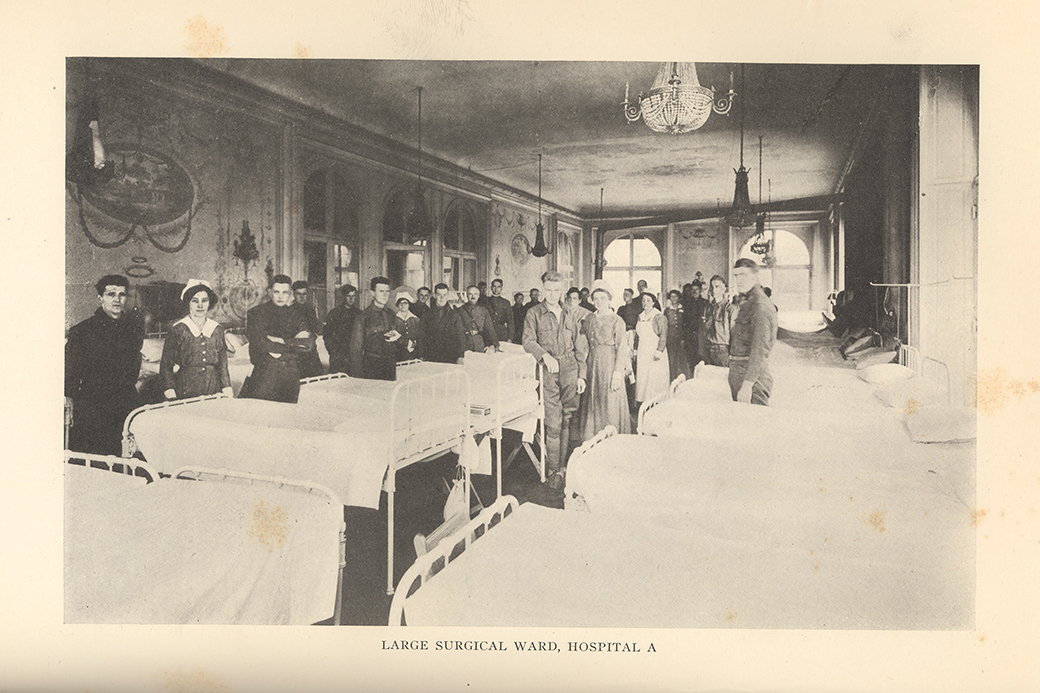
Hospital Ward

Hospital Storeroom
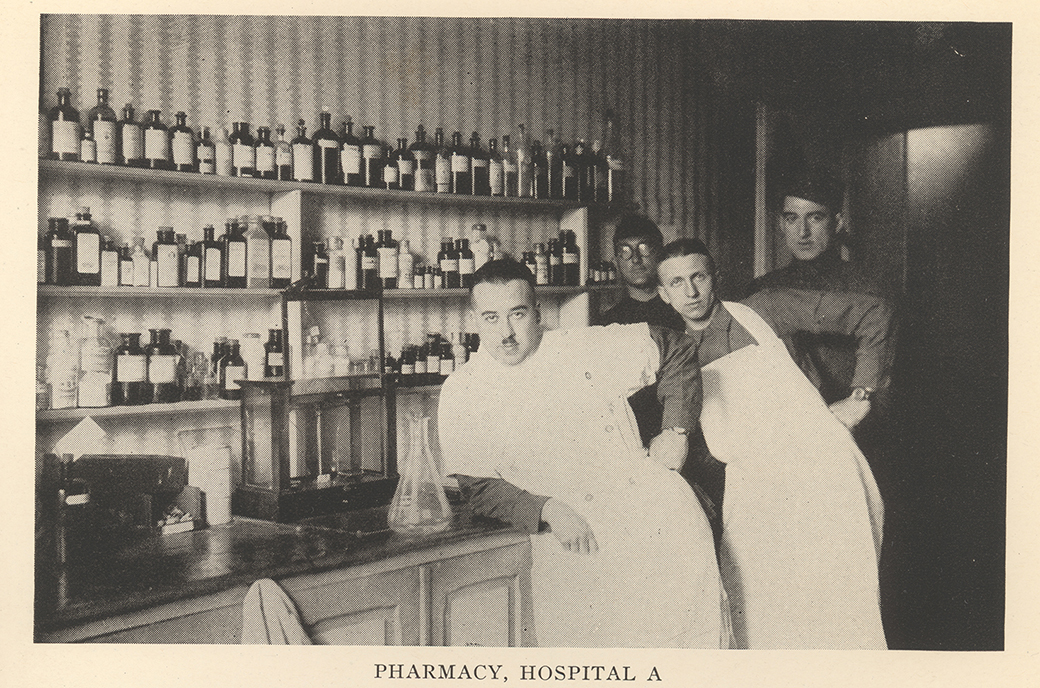
Pharmacy
Certificate of Appreciation
Formation of Base Hospital 32
Source: Hitz, Benjamin D. A history of Base Hospital 32, including Unit R. Indianapolis, 1922, p. 1-9:
The story of Base Hospital 32 begins early in February 1917. At this time, with relations between the United States and Germany becoming daily more strained, a certain group of Indianapolis physicians was already resolving to volunteer its services in event of war. The idea of organizing a hospital from Indianapolis began to take definite form on February 19, 1917, when the following letter from Mr. J. K. Lilly was received by the president of the Indianapolis Chapter of the American Red Cross.
http://mollydaniel.net/contrexeville/introbh32.html#
Contrexeville, France AEF 1917-1919
Officer's quarters
Officers' quarters for Base Hospital 32 officers were located on Rue Salabery (image from unit history of Base Hospital 32)
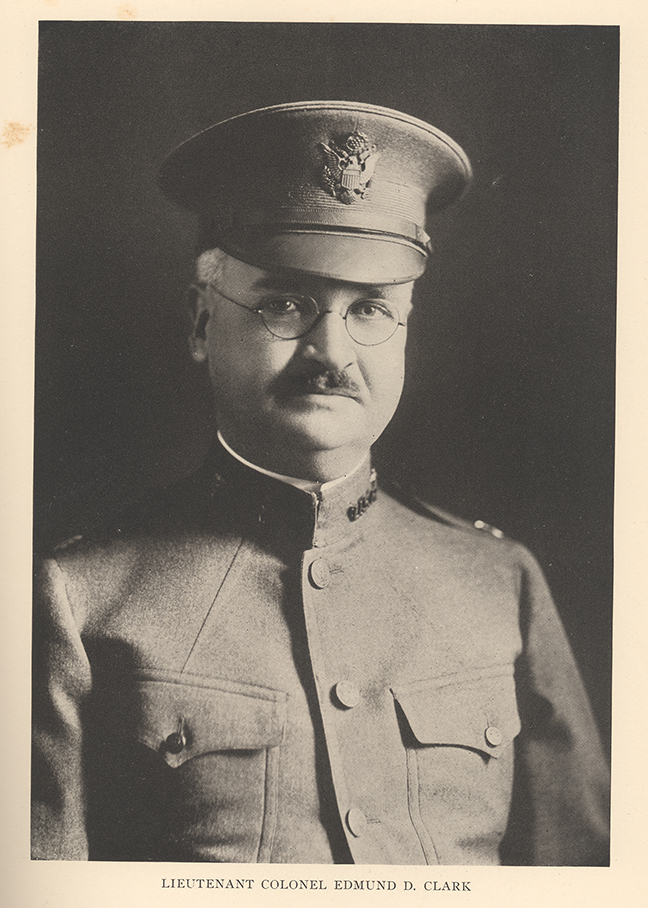
Lt. Major Dr. Edmund D. Clark of Indianapolis was appointed as director of the hospital with Miss Florence J. Martin, also of Indianapolis, being appointed chief nurse. On September 01, 1917, the officers and enlisted men of Lilly Base Hospital began training at Fort Benjamin Harrison, northeast of Indianapolis. Six days later at the Indianapolis City Hospital, the unit’s nurses took their oath, and on September 9th left for New York where they were quartered in barracks at the Columbia War Hospital, drilling and adjusting to military life. They remained in New York for three weeks before moving on to Hoboken and later Ellis Island. On the night of December 04, 1917, aboard the SS George Washington, a German ocean liner that had just recently been repurposed as a troop transport, the staff of Base Hospital 32 began their crossing of the Atlantic.
https://www.worldwar1centennial.org/index.php/indiana-in-wwi-stories/2434-base-hospital-32.html
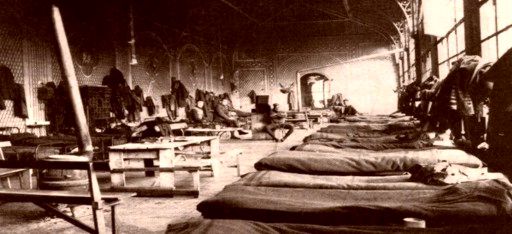
Testimonials
Elizabeth Melville, Army Nurse Corps,
Henry County, Indiana
"War horrible and unnecessary....
Martha R. Berger, Nurse, Elkhart County, Indiana
A period of high nervous tension, amounting almost to hysteria. Homesick boys trying to hide the fact of homesickness, trying to finish a disagreeable job as soon as possible.
We were located in a village which is a noted Spa, and our chemists tested the water periodically of course. It was always amusing to see and hear the “city fathers” sputter when a “non-potable” sign was put up at one of the (water) sources.
Elizabeth Melville, Army Nurse Corps, Henry County, Indiana
"War horrible and unnecessary....
Helen Augustine Thompson, Army Nurse Corps, Richland County, Illinois
Amusing incidents: "the excitement and embarrassment caused by the announcement of the chief Army nurse on Ellis Island regarding those bobbing hair, etc. Mine was already short (from scarlet fever), and I wore a transformation (wig), but many did not know this. Also the narrow escape of nearly having said transformation pulled off when getting caught in an officer's cufflinks while turning on the dance floor... The scramble to find our clothes and get dressed in the dark in our coaches when we reached Contrexeville in the wee sma' hours." Less amusing: "Deserted by our Chief Nurse and comrades and left without even our travel orders away over in La Baule, France."
Henry W. Brockenbrough, 2nd Lieutenant, Field Artillery, Tippecanoe County, Indiana (Editors note: also listed in 42nd Rainbow Div.)
Entered service in May, 1917. Stationed at Ft. Harrison, Ind., where he received commission in August, 1917. Sailed for France Sept. 11, 1917, landing Oct. 2, 1917. Attended Field Artillery School at Saumur for three months. Assigned to the 151st Field Artillery, Battery B, 42nd (Rainbow) Division in January, 1918. Went to the front in February, 1918, the 151st F. A., being in active service with the (Rainbow) Division. Saw service on the Lorraine front for 110 days, and later was moved to the Champaign sector and participated in the offensive from July 15,1918, to July 18, of the same year. Took active part in the Chateau-Thierry offensive and the St. Mihiel drive, and last at the Verdun sector.
Was wounded at Verdun Oct. 14,1918 when serving with the Infantry, and was removed to Base Hospital No. 32, where he was a patient for three weeks. Was on his way back to join his battery, Nov. 11, 1918, the day of the signing of the armistice. Also served with the Army of Occupation in Germany. Born at Lafayette, Ind., July 6, 1893, son of Mrs. Nell Wallace Brockenbrough. Graduate of Purdue University. Home is Lafayette. Ind.
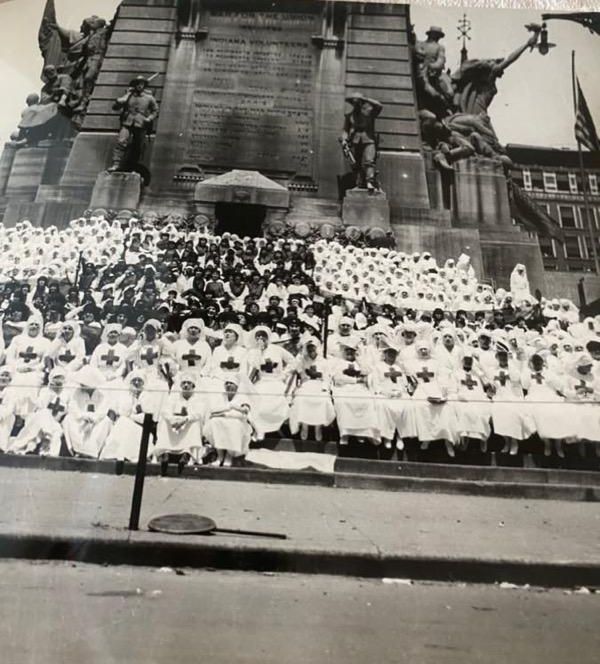
Thousands of people lined the streets in Indianapolis on May 7, 1919
to welcome home Indiana's returning World War 1 soldiers.
Women threw flowers in the path of soldiers marching up Meridian Street to the Circle, where a living Red Cross was formed on the steps of the Soldiers and Sailors Monument.
Paul Shideler/Indianapolis News https://www.indystar.com/story/news/history/retroindy/2018/05/18/
speedway-and-ims-were-crucial-aviation-hub-during-wwi/615446002/
Photo courtisy of Stan & Sarah Seivers
